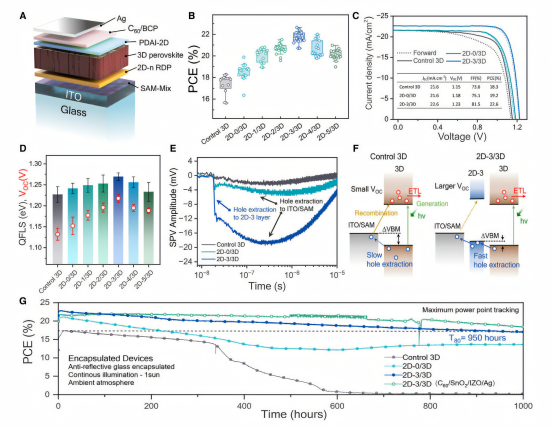
量子效率测试仪
PL/EL一体机
Sinton硅片少子寿命测试仪
Sinton硅块少子寿命测试仪
绒面反射率测试仪
3D共聚焦显微镜
清洗制绒工作站
在线四探针方阻测试仪
全自动扫描四探针方阻测试仪
在线薄膜厚度测试仪
晶化率测试仪
Horiba显微共焦拉曼光谱仪
傅里叶红外光谱仪
霍尔效应测试仪
分光光度计
全光谱椭偏仪
Horiba椭圆偏振光谱仪
TLM接触电阻率测试仪
超景深显微镜
网版智能影像测量仪
全自动影像测量仪
卧式拉力机
电池片稳态光衰老化试验箱
电池片紫外老化试验箱
电池片拉脱力综合测试仪
外观检验台
湿漏电测试系统
组件实验室EL测试仪
紫外老化试验箱
稳态光衰老化试验箱
电流连续性监测系统
PID测试系统
旁路二极管测试系统
LeTID测试系统
反向电流过载系统
脉冲电压测试系统
绝缘耐压测试仪
接地连续性测试仪
绝缘耐压接地测试仪
湿热环境试验箱
湿冻环境试验箱
热循环试验箱
动态机械载荷测试机
静态机械载荷测试机
冰雹冲击试验机
引出端强度试验机
霰弹冲击试验机
抗划伤(切割)测试机
剥离试验机
万能材料试验机(单臂)
万能材料试验机(双臂)
光伏玻璃透过率测试仪
醋酸测试试验箱
交联度测试系统
二极管接线盒综合测试仪
落球冲击试验机
半自动四探针
全自动探针式台阶仪
多通道太阳能MPPT系统
Horiba稳瞬态荧光光谱仪
钙钛矿P1激光划线测试仪
钙钛矿在线膜厚测试仪
钙钛矿工艺检测工作站
手持式IV测试仪
便携式EL测试仪
手持热成像测试仪
户外组件IV测试仪
户外组件多通道测试系统
光伏逆变器电能质量测试仪
无人机EL检测仪
叠层认证效率31.2% ! 最新Joule:通过界面工程制造高效的钙钛矿/硅串联太阳能电池
日期:2024-10-29浏览量:30
钙钛矿/硅串联太阳能电池在功率转换效率(PCE)方面最近取得了显著进展,但钙钛矿层的旋涂法面临着巨大的可扩展性挑战,量产受限。研究团队通过优化1.66 eV宽带隙钙钛矿,使用刀片涂层技术,将钙钛矿/硅串联太阳能电池达到了31.2%的认证功率转换效率(PCE)。刀片涂层叠层太阳能电池在连续照明1-sun MPPT下保持T80超过1700小时,展示了稳定性和可制造性。
2D-n型薄膜及其混合维度分布

结构维度与组成相关:图中可以清晰看到随着n值的变化,PEA-基 2D 结构发生明显改变,化学组成从n=1时的逐渐演变为PEA2PЫ4更复杂的形式,这体现了结构维度和化学组成之间的紧密联系。
混合维度特性:通过PL 发射曲线可知,2D - n 薄膜存在混合维度物种,这意味着在实际制备过程中很难获得单一维度的理想结构,这种混合维度特性可能对薄膜的光学和电学性能产生复杂的影响。
能带排列规律:2D-n薄膜的能带结构随着值变化而有规律地改变,且与控制3D刀片涂层钙钛矿和 ITO/SAM 的能带存在特定的对齐关系。这种能带排列规律对于理解电荷在不同结构间的传输机制至关重要,为优化电池性能提供了理论依据。PL 发射强度差异:不同值的物种在 PL 发射强度上存在差异。这可能是由于不同的结构维度和化学组成导致了不同的电子态密度和跃迁几率,从而影响了光致发光的强度。
通过调整2D钙钛矿薄膜的维度,可以优化与3D钙钛矿层的能量对齐,从而提高电荷提取和太阳能电池的整体性能。
2D-n/3D薄膜的光致发光特性与界面验证

底部界⾯的⼆维n型薄膜
2D层的存在:通过HR-STEM图像确认了2D钙钛矿层在埋藏界面的存在,这表明在刀片涂层过程中,2D层在一定程度上得以保留。
PLQY值的提升:2D-3/3D薄膜展现出最高的PLQY值,这可能与更好的电荷提取效率和/或更低的非辐射复合损失有关。
界面工程的影响:2D层的引入和优化可以显著影响钙钛矿/硅串联太阳能电池的性能,特别是在提高光致发光量子产率方面。
2D层的稳定性:尽管在刀片涂层过程中可能会发生部分2D层的溶解和再结晶,但这些结果表明,适当的2D层可以为3D钙钛矿层提供一个稳定的界面,从而提高整体电池性能。
2D-n层在单结p-i-n电池中的集成效果

集成2D-n层对单结p-i-n电池性能的影响
2D层的优化:引入2D层,特别是2D-3层,可以显著提高单结p-i-n电池的性能,这主要是通过改善空穴提取和减少载流子复合来实现的。
电池性能的提升:2D-3/3D电池在VOC、FF和PCE方面均展现出优于控制3D电池的性能,这表明通过界面工程可以显著提升钙钛矿太阳能电池的性能。
稳定性的改善:2D-3/3D电池在长期光照下的稳定性优于控制3D电池,这表明2D层的引入有助于提高电池的长期稳定性。
界面工程的重要性:通过调整2D层的能带结构和浓度,可以实现与3D钙钛矿层的更好能量对齐,从而提高电荷提取效率和电池性能。
封装后太阳能电池在连续1-sun光照下的最大功率点跟踪(MPPT)比较。2D-3/3D电池展现出更好的稳定性,能够在约950小时保持其初始PCE的80%,而控制3D电池在约600小时后性能下降。
刀片涂层钙钛矿/硅串联电池的性能与稳定性

刀片涂层钙钛矿/硅串联电池的相关特性
2D层的集成效果:在钙钛矿/硅串联太阳能电池中成功集成了2D层,特别是2D-3层,这有助于提高电池的整体性能。
性能提升:2D-3/3D电池在VOC、JSC和FF方面均展现出优于控制3D电池的性能,这表明通过界面工程可以显著提升钙钛矿/硅串联太阳能电池的性能。
稳定性的改善:封装后的钙钛矿/硅串联太阳能电池在连续1-sun光照条件下的最大功率点跟踪(MPPT)性能。2D-3/3D电池在约1700小时后仍能保持其初始性能的80%,显示出优异的长期稳定性。
通过MPPT测试,研究人员发现,采用2D/3D异质结构的刀片涂层钙钛矿/硅串联太阳能电池展现出了卓越的长期稳定性。2D-3/3D电池在连续1-sun光照条件下保持了超过1700小时的80%初始性能,这是太阳能电池领域的一个重要里程碑。
联系电话:400 008 6690
「美能光伏」 MPPT多通道电池测试系统,采用A+AA+级LED太阳光模拟器作为老化光源,以其先进的技术和多功能设计,为钙钛矿太阳能电池的研究提供了强有力的支持。
■ 光源等级:A+AA+,光谱匹配度A+级,均匀性A级,长时间稳定性A+级
■ 有效光斑大小: ≥250*250mm(可定制)
■ 光强可调节: 0.2sun, 0.5sun, 1sun, 1.5sun,4个档位
■ 功率独立可控:300-400 nm/400-750 nm/750-1200 nm
通过引入 2D 钙钛矿层和优化界面,提高了刀片涂层钙钛矿 / 硅串联电池的性能和稳定性,展示了线性印刷技术在高效太阳能电池制备中的潜力。美能MPPT多通道电池测试系统用于评估和优化太阳能电池在连续工作条件下的性能。通过这一系统,研究人员能够精确地跟踪每个电池在模拟实际户外光照条件下的最大功率点(MPP),并实时调整以维持最高效率。
原文出处:Subbiah et al., Efficient blade-coated perovskite/silicon tandems via interface engineering, Joule (2024), https:// doi.org/10.1016/j.joule.2024.09.014




































































